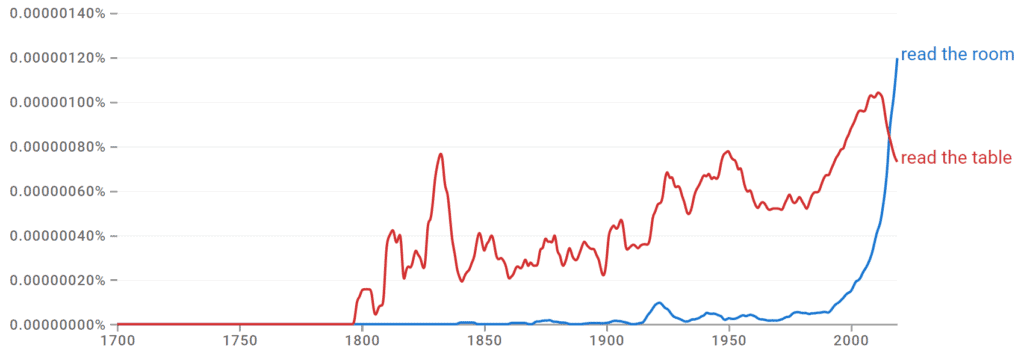Idioms are words and phrases with a figurative use separate from their literal meanings. Idiomatic phrases are popular to use to create a deeper meaning in speech and writing.
Read the room means making an observation of a group of people and making decisions based on those observations. The phrase is an idiom that is fairly recent in its use but may have older roots.
Let’s take a look at how to use the term read the room and where it originated from.
What Does Read the Room Mean?
The idiomatic phrase read the room means observing a group of people, understanding their collective mood, emotions, opinions, and tendencies, and acting on those observations. Read the room usually refers to a literal roomful of people, but it also can refer to a certain demographic or clientele.
Sentence Examples Using Read the Room
- As she walked into the conference, she quickly tried to read the room to determine the best way to convince them of the needs of the society she represented.
- Ryan obviously didn’t read the room correctly since he elicited zero response to his attempts at the sales pitch.
- If you read the room right, you should be able to determine what you need to do to convince them to listen.
Origins of Read the Room
Reading the room was originally documented in 1974 in the book Exploiters and Exploited: The Dynamics of Victimization by Israel Drapkin and Emilio Viano. The publication focuses on crimes and the psychology behind both the criminals and the victims of their crimes. To read the room originally was the name of the technique used by a thief to “case” a possible crime scene, observing the location of objects and their access to them.
However, it is likely that a variation of this term was in use long before the late 20th century. To read the table is a much older term and is still an acceptable synonym for read the room. To read the table is a well-used phrase, but its origins are not well documented. To read the table is generally believed to reference the observation of gaming or gambling tables popular in the salons in France and England during the 19th century. It may also have an even older meaning related to fortune-telling.
Like the idiom read the room, to read the table also means to attempt to understand the thoughts or emotions of the people present to determine the next move or how to appeal properly to them. Finding reliable sources related to the term is difficult.
The modern use of reading the room began to be used by marketing executives in the 1990s to mean understanding the motivations, feelings and moods of a certain group of people.
Let’s Review
To read the room is an idiom and is used figuratively to mean to observe or attempt to understand the group of people present in a room or a demographic or specific clientele. From the gathered information, one can then act on these observations to make a move or specific appeal to the people in question.
It is a modern phrase but is synonymous with the phrase “read the table,” which is much older and likely originally referring to the gambling tables popular in Victorian England and France during the 1800s.
Enjoyed reading about this idiom? Check out some others we covered:


